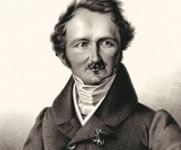Famous People
- Fairytale refuges for the fairytale king
- A paradise born of the Age of Enlightenment
- Fruits borne of strong women
- The “Sun King” of Saxony
- A romantic symbol of German history
- “My heart belongs to my garden”
- Royal life in modern times
- One masterpiece by two geniuses
- Monument to a passion for horticulture
- Count Bernadotte's flower island
- Preserving the cultural heritage
- Retreat for a king and philosopher
- A successful symphony of art and nature
- A Guelph family heirloom
Contact
Fairytale refuges for the fairytale king
Born in 1845 into the House of Wittelsbach, the shy and idealistic Bavarian yearned for the Romanticism of the Middle Ages and the grandeur of Absolutism in the French court. He died in mysterious circumstances in 1886 at Lake Starnberg. His castles brought him fame throughout the world as the “fairytale king”. He was a passionate admirer of the operas of Richard Wagner (1813-1883) and their colourful medieval worlds. The pair got to know each other in 1861 and over the years developed an almost spiritual bond in a most unusual friendship. Scenes from Wagner's musical dramas were a running theme throughout Ludwig II's castles, which were built as tributes to his “divine companion”. The composer on the other hand, who pioneered the concept of operas as all-encompassing works of art, needed his patron's money for the opera house he planned to build in Bayreuth.
Neuschwanstein Castle, Hohenschwangau
Show on map »
Linderhof Palace, Oberammergau
Show on map »
Herrenchiemsee Palace
Show on map »
Travel Planner
Select an option...
Location
- Neuschwanstein Castle, Hohenschwangau
- Linderhof Palace, Oberammergau
- Herrenchiemsee Palace



